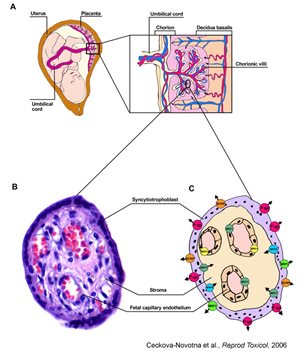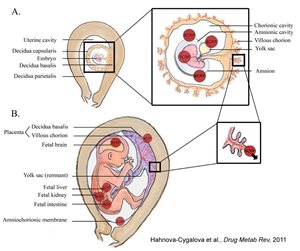Role of drug transporters in fetal protection and detoxication
Pharmacotherapy during pregnancy is often inevitable for medical treatment of the mother, the fetus or both. The knowledge of drug transport across placenta is, therefore, an important topic to bear in mind when deciding treatment in pregnant women. Several drug transporters of the ABC and SLC families have been discovered in the placenta, such as P-glycoprotein, breast cancer resistance protein, or organic anion/cation transporters. It is thus evident that the passage of drugs across the placenta can no longer be predicted simply on the basis of their physical-chemical properties. Functional expression of placental drug transporters in the trophoblast and the possibility of drug-drug interactions must be considered to optimize pharmacotherapy during pregnancy. Proper understanding of the role of placental transporters should be of great interest not only to clinicians but also to pharmaceutical industry for future drug design and development to control the degree of fetal exposure.
In this line of research we strive to investigate the importance of drug transporters in the placenta for fetus protection and detoxication. Many ABC and SLC transporters have been localized in the placenta, either in the apical (mother facing) or basolateral (fetus facing) membrane. Using several experimental techniques (in vitro cell lines, in situ prerfused rat placenta) we are currently working on several projects, such as:
-
Expression, localization and function of Organic Cation Transporter 3 (OCT3/SLC22A3) and multidrug and toxin extrusion transporter 1 (MATE1/SLC47A1) in the rat and human placenta at different stages of gestation.
-
Expression, localization and function of P-glycoprotein (MDR1/ABCB1) and breast cancer resistance protein (BCRP/ABCG2) in the placenta at different stages of gestation.
-
Study of transplacental pharmacokinetics of antiretroviral drugs (e.g. emtricitabine, tenofovir and tenofovir disoproxil fumarate); interactions with drug-efflux transporters.
-
Placental transport of oral hypoglycemic agents – Glyburide and Metformin – and their interactions with drug transporters in the placenta.

Schematic structure of the human placenta. (A) Cross section of the uterus at the term of pregnancy showing fetus connected with the placenta via the umbilical cord. In the detailed schema, structure of cotyledon, placental functional unit, is depicted. Chorion, the fetal part of the placenta, consists of chorionic plate and chorionic villi that are washed by maternal blood entering intervillous space through spiral arteries in decidua basalis. The oxygen and nutrients from maternal blood cross the surface trophoblast layer of chorionic villi, enter the fetal blood and are brought to the fetus via umbilical vein (red). The deoxygenated blood is conducted from the fetus through two umbilical arteries (blue). (B) Hematoxylin–eosin stained paraffin sections of terminal villi in human third trimester placenta (microphotograph courtesy of Dr. Nachtigal). (C) Schematic description of the terminal villi section showing localization of P-gp at the apical microvillous membrane of syncytiotrophoblast and presence of other placental drug efflux transporters.

Schematic depiction of sagittal sections of the gravid uterus in weeks 4 (A) and 22 (B) of gestation showing expression sites of breast cancer resistance protein (ABCG2/BCRP) within the placenta, fetal membranes, and developing fetus.